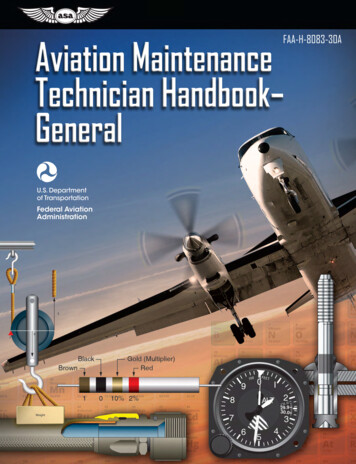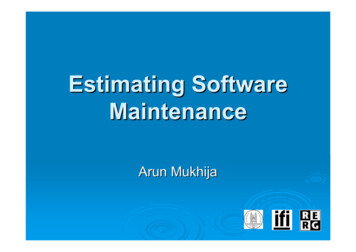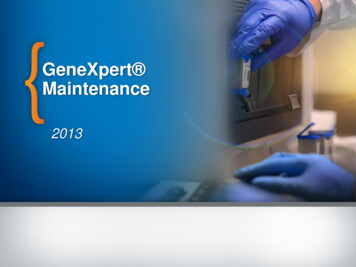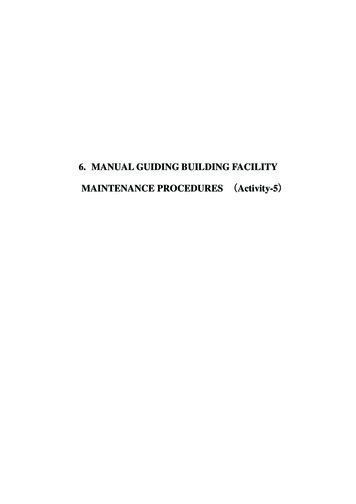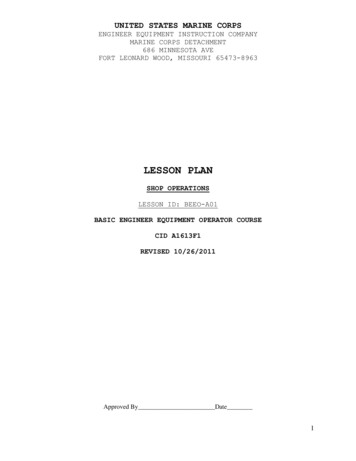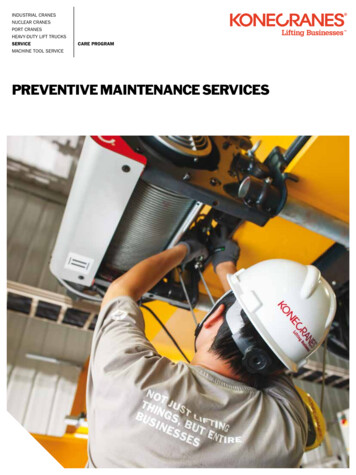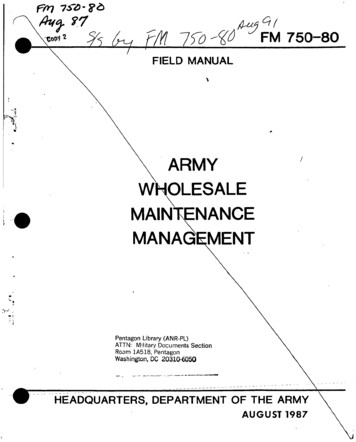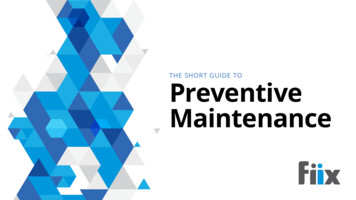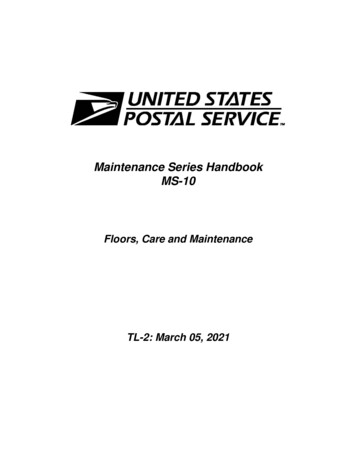
Transcription
Maintenance Series HandbookMS-10Floors, Care and MaintenanceTL-2: March 05, 2021
Published by:UNITED STATES POSTAL SERVICEHEADQUARTERS MAINTENANCE OPERATIONSMAINTENANCE TECHNICAL SUPPORT CENTER600 W. ROCK CREEK ROADNORMAN, OK 73069-8357This handbook may be used only by USPS personnel for training and maintenance. Other than for thosepurposes, no part of this publication may be reproduced or divulged to third parties in any form or mannerwithout written permission from the Maintenance Technical Support Center.Access electronic versions of handbooks from the MTSC web site on the equipment page for the specifiedequipment or in the list of Non-Equipment Related Handbooks (under Documentation) at:https://www1.mtsc.usps.govSelect “PDF” to download and print selected sections of this handbook.Suggestions for improving this handbook are solicited from all sources. To send us your comments andsuggestions, or to report MS handbook errors, please select the Handbook Comment button on the MTSCFeedback page on the MTSC web p#feedbackOrder additional copies of handbooks either by submitting a completed Form 7380 (MDC SupplyRequisition) to the Topeka Material Distribution Center using the PSIN listed below or by using the PSNlisted below when ordering by touch tone telephone:MS-10Floors, Care and MaintenancePSIN: HBKMS10PSN: 7610-02-000-9895Binder8.5-inch by 11-inch 3-ring binder with 1-inch capacityPSIN: O399APSN: 7510-02-000-8125
Floors, Care And MaintenanceTABLE OF CONTENTS. 1INTRODUCTION . 11.1SCOPE OF THIS HANDBOOK . 11.2PURPOSE . 11.3SAFETY STATEMENT . 11.4SUSTAINABILITY STATEMENT . 11.5ELECTRICAL FIRE . 11.6RESPONSIBILITIES . 21.6.1 6S . 21.7HEADQUARTERS . 21.7.1 Headquarters Maintenance . 31.7.2 Custodial Standardization Change Control Board (CSCCB) . 31.7.3 Human Resources . 31.8SENIOR POSTAL OFFICIAL (SPO) . 31.8.1 Supervisor Maintenance Operations . 4. 1IMPORTANCE OF FLOOR CARE. 12.1INTRODUCTION . 12.2TYPES OF FLOORING . 12.3FLOOR FINISHES . 1. 1SAFETY . 13.1INTRODUCTION . 13.2USPS SAFETY PUBLICATIONS . 13.3EQUIPMENT . 23.3.1 Storage . 23.3.2 Tools and Equipment Utilization . 23.3.3 Remove Equipment from Service Until Repaired . 33.4PORTABLE ELECTRIC CORD SAFETY . 33.4.1 Cord Management . 43.4.2 OSHA 1910.334(a)(2)(i) . 43.5iPOWER EQUIPMENT. 4MS-10, TL-2
Floors, Care And Maintenance3.5.1 Power Industrial Equipment (Ride-On Sweepers/Scrubbers). 43.5.2 Power-Driven, Walk-Behind Equipment . 53.6PERSONAL PROTECTIVE EQUIPMENT (PPE) . 63.7SUPPLIES . 73.8STORAGE . 73.9CHEMICAL USE . 73.10RECORDKEEPING . 83.10.1 Hazard Communication Standard: Safety Data Sheets . 83.11MATERIAL DISPOSAL . 93.12PROPER LIFTING . 93.13REPORTING UNSAFE CONDITIONS OR NEEDED REPAIRS . 103.14WET FLOORS. 10. 1CARE OF EQUIPMENT . 14.1INTRODUCTIONS . 14.2MECHANICAL EQUIPMENT . 14.3FLOOR MACHINES . 14.4POWER-OPERATED, COMBINATION SCRUBBER/VACUUMS . 24.5MECHANIZED SWEEPERS . 44.6WET/DRY VACUUMS . 54.7CARPET EXTRACTORS . 54.8MANUAL EQUIPMENT . 54.8.1 Buckets and Wringers . 54.8.2 Flat Microfiber Mops . 54.8.3 Dry Floor Cleaning Tools . 64.8.4 Squeegees. 6. 1FLOOR MATS . 15.1INTRODUCTION . 15.2ANSI / NFSI B101.6-2012 . 15.3TYPES OF FLOOR MATS . 15.4FLOOR MAT FUNCTIONALITY AND APPLICATIONS . 15.5FLOOR MAT CLEANING. 3MS-10, TL-2ii
Floors, Care And Maintenance5.6SNOW AND ICE REMOVAL MELTING COMPOUND ISSUES . 3. 1HARD SURFACE FLOOR CARE AND CLEANING METHODS . 16.1INTRODUCTION . 16.2POLICING . 16.3CLEANING . 16.3.1 Mechanized Equipment for Floor Care . 16.3.2 Damp Mopping. 36.3.3 Special Case Scrubbing Procedure . 46.4SPRAY BUFFING . 56.4.1 Solutions . 56.4.2 Equipment and Products . 56.4.3 Procedure . 66.5BURNISHING . 76.5.2 Equipment and Products . 86.5.3 Procedure . 9. 1FLOOR TYPES . 17.1INTRODUCTION . 17.2MAINTENANCE OF VARIOUS HARD FLOOR TYPES . 27.2.1 Vinyl Composition Tile (VCT) Floors . 27.2.2 Vinyl Asbestos Tile (VAT) Floors . 137.2.3 Asphalt Plank Floors . 257.2.4 Terrazzo and Marble Floors . 387.2.5 Manual Stripping Terrazzo and Marble . 397.2.6 Mechanized Terrazzo and Marble Stripping . 407.2.7 Sealing and Finishing Stripped Terrazzo and Marble . 427.2.8 Maintaining Terrazzo and Marble Finish. 437.2.9 Recoating Terrazzo and Marble with Finish . 447.2.10 Buffing or Burnishing Terrazzo and Marble . 457.2.11 Wood Floors. 467.2.12 Concrete Floors . 517.2.13 Cork Floors . 59iiiMS-10, TL-2
Floors, Care And Maintenance7.3MAINTENANCE OF CARPET . 63. 1SOLUTIONS FOR COMMON PROBLEMS . 1. 1STAIN REMOVAL GUIDE . 1. 1COMPUTER ROOM FLOOR CARE . 1B.1INTRODUCTION . 1B.2FLOOR TYPES . 1B.3CLEANING PROCEDURE FOR HIGH-PRESSURE LAMINATED TILE FLOOR 1B.3.1 Damp Mopping. 1B.3.2 Periodic Maintenance . 2B.3.3 Spot Removal. 2B.4CLEANING PROCEDURE FOR VINYL ASBESTOS TILE FLOOR . 2B.4.1 Damp Mopping. 2B.4.2 Periodic Maintenance . 2APPENDIX C . 1MS-10, TL-2iv
Floors, Care And MaintenancePREFACEThis handbook on floor care and maintenance applies to all facilities occupied by theUnited States Postal Service (USPS) where USPS is responsible for cleaning andmaintenance.This handbook provides guidance for installation heads, postmasters, station managers,maintenance managers and others responsible for the care and maintenance of floors.All employees engaged in the maintenance or cleaning of floors are required to befamiliar with the contents of this manual.These procedures must be followed in order to prolong the life of our floors whileobtaining the required level of appearance.vMS-10, TL-2
Floors, Care And MaintenanceTHIS PAGE BLANKMS-10, TL-2vi
Floors, Care And MaintenanceINTRODUCTION1.1SCOPE OF THIS HANDBOOKThe scope of this handbook is to provide direction on proper floor care and maintenancein Postal Facilities. This manual should be supplemented with manufacture'srecommendations on specific equipment and products. The Senior Postal Official(SPO) is responsible for following the procedures and policies in this manual at eachindividual site.1.2PURPOSEThe following are standard safety precautions that do not appear elsewhere in thishandbook except where special emphasis or precaution is required. Personnel workingon floor care must understand and apply these precautions in all phases ofmaintenance.Safety is the responsibility of every individual in the U.S. Postal Service. The supervisoris responsible for instructing personnel in safety practices applicable to the operationand maintenance of the equipment. Likewise, it is the responsibility of each individualoperating and maintaining any equipment, products, and/or processes to understandand observe established safety standards and procedures. U.S. Postal ServiceHandbook EL- 803, Maintenance Employee's Guide to Safety, can be viewed onhttp://blue.usps.gov or ordered from the Material Distribution Center (MDC).1.3SAFETY STATEMENTTo ensure the safety of all employees and customers, Floor Care activities shall followorganizational practices as outlined in Maintenance Employee’s Guide To Safety,EL-803 and other related documents. Employees must complete training on safetyprocedures and Personal Protective Equipment (PPE) associated with hazards to whichthey are exposed. Some cleaning procedures require handling hazardous material(s)(including Blood Borne Pathogens), environmentally sensitive material(s), climbing onladders, and/or using personnel lifting equipment. Personnel must refer to the currentSafety Data Sheet (SDS) handling requirements for all hazardous or environmentallysensitive material used when performing any tasks. Personnel must observe all SDSwarnings, use PPE as directed, and use appropriate safety harnesses on ladders orpersonnel lifting equipment when required.1.4SUSTAINABILITY STATEMENTThe Postal Service is committed to minimizing our environmental footprint in ways thatare sustainable to our business and the customers we serve. The Postal Servicecomplies with all applicable federal, state, and local environmental laws and regulationsseeking to develop sustainable solutions for a safe and healthful working environment.1.5ELECTRICAL FIRERefer to MS-56 Fire Prevention and Control.1-1MS-10, TL-2
Floors, Care And Maintenance1.61.6.1RESPONSIBILITIES6SEvery employee shares responsibility for good housekeeping, the proper disposal oftrash, and maintaining a safe and healthful working environment in accordance with thecontinuous improvement 6S philosophy. The 6S program focuses on organizationalcleanliness and standardization to improve profitability, efficiency, and safety byreducing waste of all types. It provides five keys to a total-quality environment(Table 1-1).Table 1-1. 6S: A visual control system for the workplaceSortEliminate unnecessary items and whatever isnot requiredStraightenArrange workplace in such a way that workflows smoothly, free of waste.Systematic CleaningClean workspace and all equipment.StandardizeEnsure uniform setups throughout the operationto promote interchangeability.SustainMaintain effective and efficient conditionswithout falling back into less productive workconditions.SafetyEnsure each employee establishes a work ethosof following all safety guidelines. EmployeeSafety, Welfare, and Well-Being are a primaryUSPS goal.Employees of each work area are responsible for the proper disposal of trash andrecyclable materials such as plastic straps, labels, rubber bands, food waste, paper,and cardboard. Every employee must assume responsibility for disposal or recyclingexcess material produced by his or her work activities. Employees must place wastematerial in the proper containers.1.7HEADQUARTERSUSPS Headquarters develops and manages the national implementation of policiesaffecting the floor care and the cleanliness of postal facilities.MS-10, TL-21-2
Floors, Care And Maintenance1.7.1Headquarters MaintenanceHeadquarters (HQ) Maintenance Operations is responsible for establishing andmanaging national policy affecting custodial operations. HQ Maintenance Operationsevaluates the effectiveness of field custodial operations and monitors technologicaladvances and improvements that may further improve these policies. HeadquartersMaintenance Operations inspects and reviews field operations to verify cleaning policiesin accordance with schedules established by the most current MaintenanceManagement Orders (MMO). HQ Maintenance Operations is responsible to:Maintain, update, and revise national team cleaning methodology and administrativeprocedures.Manage the Custodial Standardization Change Control Board (CSCCB).Coordinate custodial training development and delivery.Select Products and Tools used in the care and maintenance of floors.1.7.2Custodial Standardization Change Control Board (CSCCB)The processes, tools, equipment, and chemicals used to support team cleaning arecontrolled, and cannot be changed, without approval from the CSCCB. This committeeestablished by HQ Maintenance Operations receives, evaluates, and approves ordenies each Custodial Change Request (CCR).The Manager Maintenance Operations, Headquarters appoints the committeechairperson and its voting members. The committee chairperson identifies subjectmatter experts who conduct a technical evaluation of each change request. The boardmembers will utilize the tools and process of Lean Six Sigma when evaluating CustodialChange Requests.1.7.3Human ResourcesThe Headquarters Safety and Health organization is responsible to work with HQMaintenance Operations to ensure all aspects of the team cleaning program complywith applicable rules and regulations governing custodial operations.The National Center for Employee Development (NCED) is responsible to maintain,update, and revise all team cleaning training materials with guidance and oversight fromHQ Maintenance Operations.1.8SENIOR POSTAL OFFICIAL (SPO)Each SPO is responsible to ensure a safe and healthful environment for all facilityoccupants and must assure that the floors are maintained at a satisfactory level. Theinstallation head must raise employee awareness and promote employee commitmentto maintain a clean and healthful working environment. The SPO shall ensure that floorcare and maintenance in their facility follow MS-47 Team Cleaning policy.1-3MS-10, TL-2
Floors, Care And Maintenance1.8.1Supervisor Maintenance OperationsIndividuals that supervise custodial operations have major responsibilities in the careand maintenance of floors including following policy, training of employees, effectiveutilization of the custodial workforce, notifying senior management of changingworkloads or conditions, performing employee observations, and enforcing postal safetypolicy.MS-10, TL-21-4
Floors, Care And MaintenanceIMPORTANCE OF FLOOR CARE2.1INTRODUCTIONIn most postal facilities, floors represent a large capital investment. The life of the floorscan be prolonged with proper care and scheduled maintenance. Additionally, well-keptfloors reflect good housekeeping practices and promote a safe and healthfulenvironment for customers and employees.Many types of flooring exist throughout the USPS. Each type may require a differenttreatment during cleaning operations. The various types of floors react differently tocompounds used in their cleaning. Improper cleaning techniques can affect the finish offloor surfaces; therefore, the cleaning materials used must not harm the particular typeof floor. For example, wood floors are absorbent and can be easily damaged by water.Asphalt plank and rubber flooring materials are not easily affected by water, but can bedamaged by oils or solvents.This handbook is not intended to be all inclusive, but is intended to be used as a basisfor floor care and maintenance.2.22.3TYPES OF FLOORING Asphalt Plank Carpet Concrete Ceramic Vinyl Composite Tile (VCT)/Vinyl Asbestos Tile (VAT) Vinyl Sheet/Linoleum Rubberized Terrazzo/Marble WoodFLOOR FINISHESA floor finish is a product that is applied to a hard floor and dries to a hard, durable, andsmooth film. This film is about the thickness of waxed paper and is expected to protectand extend the life of the floor while providing an attractive appearance and slipresistant surface. After repeated mopping, the floor retains the finish, slip resistance,and durability.2-1MS-10, TL-2
Floors, Care And MaintenanceTHIS PAGE BLANKMS-10, TL-22-2
Floors, Care And MaintenanceSAFETY3.1INTRODUCTIONSafety is the responsibility of every individual in the USPS. Accidents result fromunsafe acts or unsafe conditions. Accidents do not just happen; they can be preventedby using common sense and staying alert in the performance of all tasks. The USPShas the responsibility of providing a safe and healthful working environment for itsemployees. The supervisor has the responsibility of instructing employees in safetypractices applicable to the operation and maintenance of the equipment.Whenever using any equipment or products you must follow the Personal ProtectionEquipment (PPE) requirements from that product or equipment.Whenever performing any work on floors be sure to use the appropriate safety methodsto secure the area protecting building occupants and employees performing the task.3.2USPS SAFETY PUBLICATIONSUSPS handbooks and publications relative to safety are as follows:3-1 EL-801, Supervisor's Safety Handbook EL-803, Maintenance Employee's Guide to SafetyMS-10, TL-2
Floors, Care And Maintenance3.3EQUIPMENT3.3.1StorageJanitorial carts, microfiber mops, mop wringers, buckets, or other equipment must notbe left where someone may trip over them (Figure 3-1). Always store equipment off theworkroom floor in approved areas.Figure 3-1. Janitorial Cart Storage3.3.2Tools and Equipment Utilization3.3.2.1Electrical EquipmentImproper use of electrical equipment creates a potential shock hazard. Inspect electriccords on equipment, including extension cords, before using. DO NOT USE portablepower equipment with a frayed, worn, or damaged cord. Extension cords must be visually inspected for external defects before use. Prior to starting each shift visually inspect portable equipment and extensioncords. Immediately report equipment and / or extension cord damage to the supervisor. Remove the damaged equipment or cord from service. Record damage on the “Equipment Check-In/Check-Out Log. Obtain replacement equipment / cord and inspect for damage.MS-10, TL-23-2
Floors, Care And MaintenanceRemove equipment with frayed cords, loose wiring, and defective grounds or plugs fromservice. Attach a properly completed Form 4707, Out of Order (tag), to defectiveelectrical equipment immediately. A sample of a properly completed Form 4707 isshown in Figure 3-2.Figure 3-2. Form 4707, Out of Order (tag)3.3.3Remove Equipment from Service Until RepairedDo not remove Form 4707 from defective equipment of any type until it has beenproperly repaired. Have damaged power cords (cut, worn, frayed, missing groundprong or broken, as shown in Figure 2-3) replaced by authorized personnel. Repairingpower cords by applying electrical tape is unacceptable.3.4PORTABLE ELECTRIC CORD SAFETYAlways exercise caution and common sense to prevent any potential cord trippinghazards and practice proper lifting techniques when picking up the bundled cord tomove to another work location.3-3 Portable equipment must be handled in a safe manner not causing injury or harmto personnel. Flexible electric cords connected to equipment must not be used for raising orlowering the equipment. Flexible cords must not be hung in such a fashion as could damage the outerjacket or insulation.MS-10, TL-2
Floors, Care And Maintenance3.4.1Cord ManagementWhen using power equipment ensure that the cord is properly managed. If possible,position the cord such that it is behind you in the opposite direction of travel.Use proper cord wrapping techniques to reduce, if not eliminate, tangling of the cord.Lay the cord out rather than dropping it in a pile on the floor. Remember to bend at theknees when picking up the cord from the floor.Minimize allowing the cord to cross aisles reducing the potential tripping hazard and forcord to be run over or entangled in mail transport equipment.Ensure the equipment power switch is in the off position before connecting ordisconnecting electrical equipment to or from the power supply.3.4.2OSHA 1910.334(a)(2)(i)Portable cord and plug connected equipment and flexible cord sets (extension cords)shall be visually inspected before use on any shift for external defects (such as looseparts, deformed and missing pins, or damage to outer jacket or insulation) and forevidence of possible internal damage (such as pinched or crushed outer jacket). Cordand plug connected equipment and flexible cord sets (extension cords) which remainconnected once they are put in place and are not exposed to damage need not bevisually inspected until they are relocated (Figure 3-3).Figure 3-3. DAMAGED FLEXIBLE CORD3.5POWER EQUIPMENTTag equipment that is defective with a properly completed Form 4707, Out of Order(tag). Immediately notify supervisor about defective equipment.3.5.1Power Industrial Equipment (Ride-On Sweepers/Scrubbers)Follow the requirements listed below for ride-on equipment: Refer to EL-803, Maintenance Employee's Guide to Safety. Inspect equipment for defects or unsafe condition before using it. Following the manufacturer's operating instructions and related USPS Manualsand MMO’s. Check all pertinent parts of the equipment, such as brushes, forabnormal wear and check safety lights to ensure that they are operational.Report defects to supervisor immediately. Do not use defective equipment.MS-10, TL-23-4
Floors, Care And Maintenance When using any powered equipment, be particularly alert to pedestrian andvehicular traffic. Do not leave the keys in equipment when it is unattended. Keep children away from equipment. Empty and clean equipment prior to storage.3.5.2Power-Driven, Walk-Behind EquipmentFollow the requirements listed below for power-driven, walk-behind equipment:3-5 Inspect equipment before using it. Following the manufacturer's operating instructions and related USPS Manualsand MMO’s. Check pertinent parts of the equipment, such as brushes, forabnormal wear. Do not use any defective equipment. If equipped with vacuum bags, ensure that they are in good condition and are notfull. When using any powered equipment, be particularly alert to pedestrian andvehicular tra
When using a floor machine, with the power cord disconnected from power source, tilt the handle down and place the brush on the machine by hand. Never place the machine over the brush and attempt to lock it in place by clicking the start switch. Examine the brush before each use, ensuring that the drive plate screws or bolts are tight.

